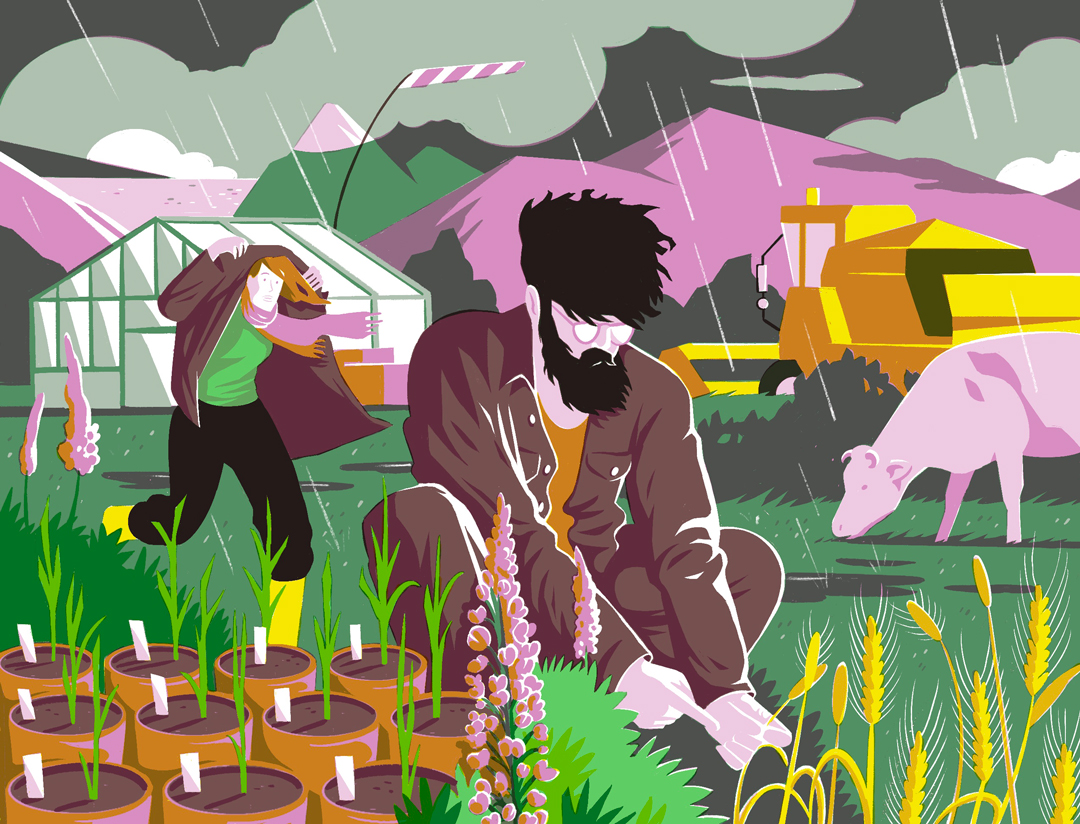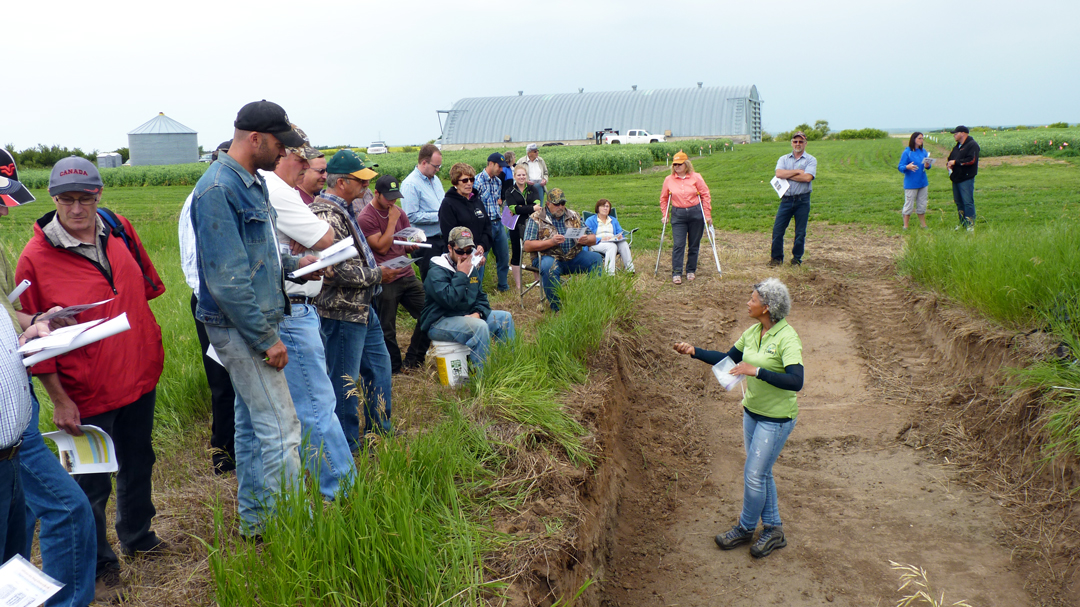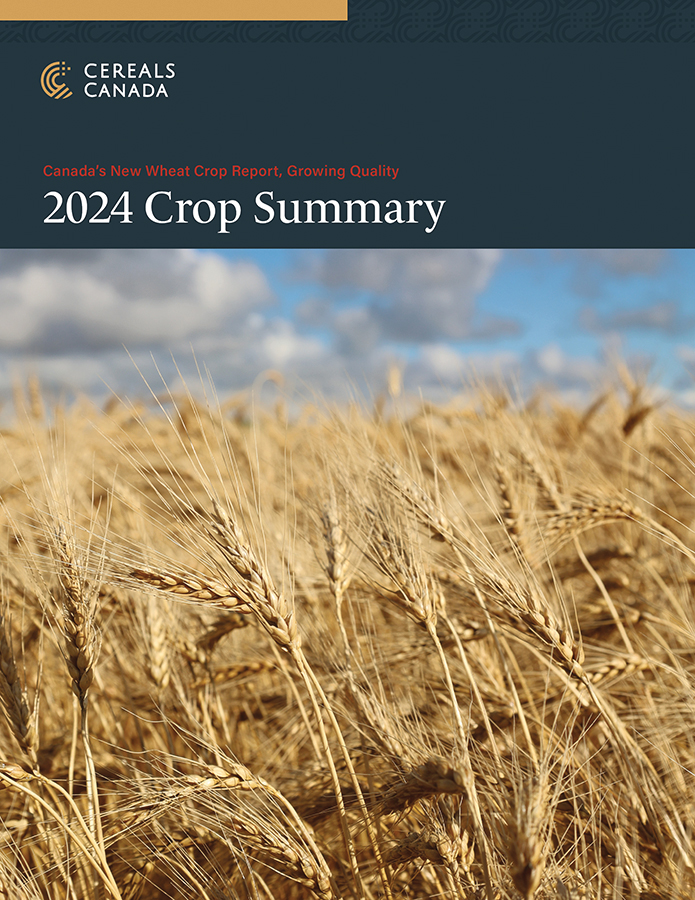HIGH LATITUDE BARLEY
BY EMILY R. JOHNSON • ILLUSTRATION BY TILL LUKAT
Each spring, Hrannar Smári Hilmarsson travels 10,000 kilometres across Iceland to seed barley research plots. As he works against unforgiving elements and sluggish soil temperatures, his quest is to deliver self-sufficiency in grain production for the island nation.
GREAT EXPECTATIONS
Raised in villages across Iceland, Hilmarsson worked on sheep and dairy farms in southeast Iceland during his childhood. This closeness to the land led him to study agricultural sciences at the Agricultural University of Iceland in Hvanneyri, a tiny, idyllic rural community on the country’s west coast. There, he focused on soil health but turned to the genetics of woodland strawberries to complete his undergraduate and master’s degrees. With his sights set on pursuing a PhD in the United States, he accepted what he thought was a temporary role as a barley research assistant. “Fate happened,” said Hilmarsson. “I continued working on barley research in Iceland and have been here ever since.”
He now leads the Vala Plant Breeding Program at the university where he once studied. The government-funded initiative aims to increase Iceland’s self-sufficiency and bolster its food supply through the production of barley, oats and winter wheat. Hilmarsson is driven by the progress he has seen in the initiative. “The only reason I get up in the morning is because it’s helping farmers and improving the livelihoods of our people on this island,” he said.
Such drive is necessary to overcome the challenges he’s up against. Early in his career, he learned to take the unexpected in stride and sees surprising results as a good thing. “I’ve tried to adopt the view that problems are exciting. As a scientist, if something comes out that is unexpected, that is amazing, and you should get excited about it.” He’s confident the program will deliver surprisingly positive results.
LITTLE LAND, HARSH ELEMENTS
Historically, Iceland’s agricultural sector focused heavily on livestock breeds introduced by Viking settlers that include cattle, goats and sheep, grazers that rely heavily on abundant grasses that thrive in the cool conditions. A source of great pride for Icelanders, production of the animals is supported by national research programs.
A 2021 report by Iceland’s Ministry of Industry and Innovation notes the country has been surprisingly self-sufficient in agricultural production. At the time, horticultural production of vegetables supplied 43 per cent of consumption, livestock farming close to 90 per cent, 96 per cent of egg and 99 per cent of dairy. Domestic grain production, however, stood at just one per cent of consumption.
Icelandic consumption of sheep has declined significantly in recent years. Poultry has become the most consumed animal protein, with eggs and pork also gaining popularity. Chickens and pigs require feed containing cereals such as wheat, barley and oats, crops historically unsuited to Iceland’s harsh climate. Reliance on imported feed is considered a food security risk.
To grow cereals in this northerly country is tricky. The same study admits estimates of the extent of arable land are approximate but suggests between 200,000 and 600,000 hectares are suitable for crops and fodder. It also suggests two thirds of this may potentially be sown to grain such as barley. Very little grain is now grown on the Island, but its potential is tantalizing. Much of the soil contains volcanic ash, sand and permafrost, while its high-organic, peat-based soils are deep and rich. Given their quality, said Hilmarsson, Iceland could be an agricultural powerhouse, if only it was located 10 latitudinal degrees southward.
As in Western Canada, the country’s growing season runs from late April through September. However, soil and air temperature remain quite cool. Even early crops such as barley struggle to mature.
Located just south of the Arctic Circle, Iceland experiences long daylight hours in summer. Though this approaches 24 hours per day in June, Hilmarsson noted Iceland gets the fewest sunshine hours of any European nation. “These daylight hours would be great if it ever stopped raining.” Close to harvest, crops face extreme pressure from heavy rain and strong winds that test straw strength and standability. Farmers commonly harvest grain with moisture levels as high as 40 per cent. In waiting for a field to dry, a farmer risks shattering and straw breakage. “When the farmers ask me when they should harvest, I tell them, ‘the day before it blows away,’” said Hilmarsson.
A GRAIN BREEDING PIPELINE
Under Hilmarsson’s leadership, the Vala Plant Breeding Program was launched in 2023. Its primary goal is to make Iceland self-sufficient in grain production for food and livestock feed.
The Vala Program is largely focused on barley research. An earlier barley program was discontinued in 2017 when the breeder in charge, Jónatan Hermannsson, retired after 30 years on the job. However, the defunct program provided a substantial foundation for the new one. Hilmarsson attributes much of the success of the Vala Program to the work of his predecessor and other accomplished breeders. “We’re standing on the shoulders of giants all the time,” he said.
In building his case for government funding, Hilmarsson emphasized barley is a foundational crop. Although wheat plays a more significant role in Iceland’s economy due to higher consumption, the study of its cultivation has only recently begun, and it is not yet grown by Icelandic farmers. Hrannar and his team hope winter wheat production will one day supply a portion of demand from the country’s livestock and fish farming sectors. It may also potentially be used to combat soil erosion where winter snow cover is sparse.
Oats form the third pillar of the program. Iceland has conducted extensive research on oat production in collaboration with other Nordic countries. This has provided a good starting point for the launch of a breeding program.
The barley breeding program concentrates on three key traits: early maturity, yield and test weight, which is an indicator of grain density and quality. In the cool Icelandic climate, the growth speed a plant requires to reach maturity may come at the sacrifice of yield. The winter wheat breeding program will focus on the same traits as barley, plus winter survival and falling number.
“I’m sitting on 64 degrees north, the campus of the Agricultural University of Iceland. I’m on the south of Iceland, and we go all the way to just under 66 degrees, and for you, that’s like central Yukon,” he said. “So, it is a huge challenge to do this, and very exciting.”
Each spring, to gather a wide variety of data, Hilmarsson conducts barley trial plots in six locations. These are conducted on land provided by willing farmers. Most happen to raise dairy cattle. He emphasized the importance of their participation in the encouragement of grain production. “Farmers take advice from specialists with care, but they listen to other farmers. Peer-to-peer knowledge sharing is the most important seed we plant.”
GLOBAL COLLABORATION
Despite its small population and remote location, Iceland is an active collaborator in global agricultural research, particularly within the Nordic region. In addition to his leading research role at the Agricultural University of Iceland, Hilmarsson serves as vice-chair of the board of directors for NordGen, a Nordic gene bank and genetic knowledge resource.
A key initiative under NordGen’s stewardship is the Svalbard Global Seed Vault, operated in partnership with the Norwegian Ministry of Agriculture and Food. Situated on a mountainside in Svalbard, a Norwegian archipelago at the confluence of the Arctic and Atlantic oceans, it is the world’s largest seed repository. Safe from natural and manmade threats, the facility now stores more than 1.3 million seed varieties from across the world. Hilmarsson took part in a major vault deposit last year and has mixed emotions about this global collaboration. “The beautiful part is that all of humanity is working together on saving our seeds,” he said. “The scary part is we don’t trust each other to not ruin them through our activity. We know that we must put them away from ourselves, otherwise they might get lost.”
A SELF-SUFFICIENT ICELAND
Hilmarsson’s work aims to enhance Icelandic food security and serves as a research model for other cold-climate regions. It challenges the barriers that have hindered grain production in the far north.
His vision is long-term. Under his leadership, the Vala Program is making remarkable progress toward Icelandic grain self-sufficiency. By 2028, he anticipates the release of a new barley variety, followed closely by the introduction of Iceland-adapted winter wheat. “In 10 years, I want the headlines to read: ‘Iceland no longer imports barley,’” he said. “And by then, we’ll be growing our own winter wheat, too.”







Comments